How To Grill Fish
Does grilling leave you fishing for compliments? Have no fear, simply follow these three simple guidelines and five rules for grilling flawless fish fillets every time. Not sure what fish to buy? Read on. How should you prep the grill and the fish? That's covered. Not sure when the fish is done? Follow our test for doneness. This step-by-step technique article walks you through all you need to know about How To Grill Fish.

Grilling is one of the best ways to cook fish. Unfortunately, it can be tricky. Lean fish fillets are prone to sticking, leaving many grillers “burned” as their pricey fillets end up in the ashes. But don’t despair, there’s no need to cross fish off your “must-grill” list quite yet. The following three guidelines, plus the five rules are critical for perfectly grilled fish fillets.
3 GUIDELINES TO CONSIDER
Types of fish to grill: The first step to perfect grilling is choosing the right fish. You’ll have a much easier time at the grill. Tuna and salmon are great, but fresh, sturdy, white fleshed swimmers, like swordfish, snapper, grouper, mahi mahi, and halibut are also great choices for grilling. Their texture and density hold up well to the direct heat of the grill. But there are lots of other options out there too. Keep your eyes peeled for some of the fish currently making a splash in the culinary world, and check out SeafoodWatch.org for the most sustainable choices.
Thickness: As a rule, purchase 1-inch-thick fillets. Thinner ones are more apt to flake apart on the grill, unless grilled skin-on, which we don’t recommend — the skin tends to stick like crazy. And fillets thicker than 1-inch usually dry out on the surface before the inside is cooked through.
Cooking: Determining when to pull fillets from the fire isn’t easy, but a good rule of thumb is to grill 8–10 minutes per inch. So grill 1-inch-thick fillets for 4–5 minutes per side, then test for doneness as shown in the tip, below.
5 RULES of grilling fish
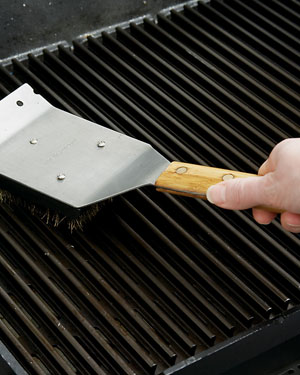
1. Preheat & clean the grill Think your grill is clean? Scrub it again — fish clings to any debris on the grates. And be sure the grill is hot! Preheat to high, then reduce to medium-high before placing fillets on.
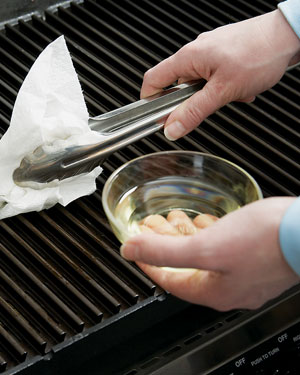
2. Oil the grate A well-oiled grill is essential, but too much oil dripping into the fire is a recipe for flare-ups. Grip a paper towel with tongs, dip it in cooking oil, then rub lightly on the grates.
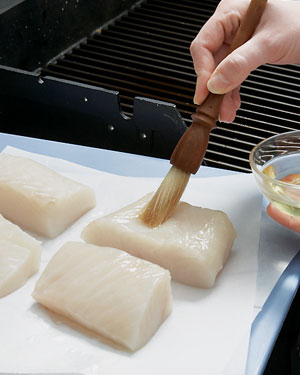
3. Oil & season Brush fillets with oil as a second defense against sticking. But don’t overdo it. Too much oil can make the fish sooty over the flame. And don’t forget to season your fish with salt and pepper.

4. Give it a nudge As you place a fillet onto the grill, give it a quick nudge with the turner. This keeps the fillet from sticking in that exact spot, so you’ll have an easier time removing it later.
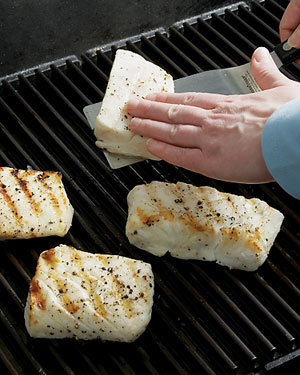
5. Searing releases After situating the fish on the grill, don’t move it until a sear forms between metal and flesh. Once seared, it easily releases. If the fish sticks, cook 30 seconds longer and try again.
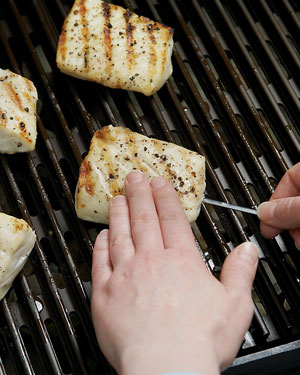
A TIP FOR DONENESS
Not sure if the fillet is done? This trick works every time. Push a metal skewer into the center of the fillet. If it inserts easily into the flesh, the fish is done. If not, cook a bit longer and check again. And invest in a sturdy turner that’s large enough to hold entire fillets. One with a beveled edge ensures the fish ends up on your plate, not stuck to the grill.
Product Recommendations
Interested in cooking? Need some supplies?
Check out some of the tools we like. All products featured on Cuisine at Home are independently selected by our editors; we may earn an affiliate commission from qualifying purchases through our links.